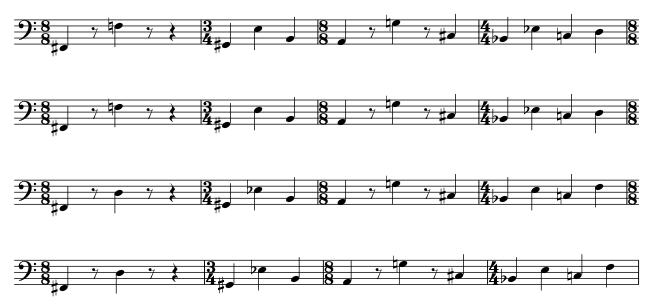This is the third in a series of post-performance analyses of my Concerto for Two Double Reeds. You can also read about I — Tessellations and II — Meta-Canon.
The structure of this movement is fairly simple, building up a contrapuntal structure over a double-bass ostinato. Click here to have a look at the score or listen to the live recording*.
The ostinato itself is made of two 4-bar phrases, each repeated. Each phrase has 12 notes: each of the notes of the pentatonic scale, although the sequence is not used as a row. The rhythm alternates between 3-quaver and 2-quaver beats to give a distinctive rhythmic identity to the whole movement.
Over this ostinato, the bassoon and orchestra conduct a dialogue which builds up a contrapuntal texture. High in my mind at the time of writing this were Kerry Andrew‘s wonderful performances of folk songs, delivered live with just a loop console for accompaniment. I love the textures she can create by laying down one part over another, and the way the piece slowly comes together, and wanted to explore this idea with an ensemble, acoustic piece. Another image that springs into my mind with this music is that of a 3D printer, which can create a solid artefact by laying down layer upon layer of 2-dimensional material.
The movement is divided into 16-bar sections. In each, the bassoon plays two 4-bar phrases, each of which is then repeated immediately in the strings. In the following section, the string part that has already been layed down is played again, and the new material is played by the next part up. This means that the cellos repeat their material 4 times, whereas the first violins only get one exposition.
This cumulative structure is repeated twice, with different material. In the first, the material of the ostinato is performed first, and played by the cellos (as well as continuing in the double bass); in the second part, this material is saved for the last entry, and appears in the first violins. As each section builds up, the dynamic increases; at the end of Section 1 we drop back to 16 bars of ostinato played pianissimo in the double bass; at the end of Section 2 we hear the ostinato played in octaves by all the performers, crescendo to fortississimo, and which point the movement stops dead.
The material is fairly straightforward. Some phrases are derived from the ostinato, and others play with chains of intervals. My intention was that there should be a range of different syncopations, so as to achieve a rhythmic counterpoint alongside the melodic counterpoint. I made no attempt to inject any harmonic meaning into the parts, but made sure there was a good range of tessitura so as to keep the identities of the parts fairly distinct.
Note: if you would like to listen to a recording of this performance, please get in touch and I can send you a link.
(*Please read my note on copyright.)

One thought on “Concerto for Two Double Reeds in detail: III — Loops”